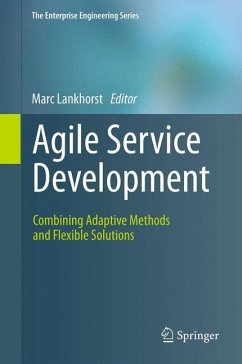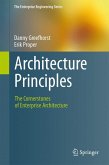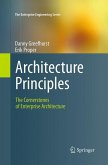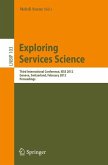Economies around the globe have evolved into being largely service-oriented economies. Consumers no longer just want a printer or a car, they rather ask for a printing service or a mobility service. In addition, service-oriented organizations increasingly exploit new devices, technologies and infrastructures. Agility is the ability to deal with such changing requirements and environments. Agile ways of working embrace change as a positive force and harness it to the organization's competitive advantage.
The approach described in this book focuses on the notion of a service as a piece of functionality that offers value to its customers. Instead of solely looking at agility in the context of system or software development, agility is approached in a broader context. The authors illustrate three kinds of agility that can be found in an agile enterprise: business, process and system agility. These three types of agility reinforce each other and establish the foundation forthe agile enterprise. Architecture, patterns, models, and all of the best practices in system development contribute to agile service development and building agile applications.
This book addresses two audiences. On the one hand, it aims at agile and architecture practitioners who are looking for more agile ways of working in designing and building business services or who are interested in extending and improving their agile methods by using models and model-based architectures. On the other hand, it addresses students of (enterprise) architecture and software development or service science courses, both in computer science and in business administration.
The approach described in this book focuses on the notion of a service as a piece of functionality that offers value to its customers. Instead of solely looking at agility in the context of system or software development, agility is approached in a broader context. The authors illustrate three kinds of agility that can be found in an agile enterprise: business, process and system agility. These three types of agility reinforce each other and establish the foundation forthe agile enterprise. Architecture, patterns, models, and all of the best practices in system development contribute to agile service development and building agile applications.
This book addresses two audiences. On the one hand, it aims at agile and architecture practitioners who are looking for more agile ways of working in designing and building business services or who are interested in extending and improving their agile methods by using models and model-based architectures. On the other hand, it addresses students of (enterprise) architecture and software development or service science courses, both in computer science and in business administration.
"The authors provide a blueprint for charting a path where agility becomes an outcome and attribute of system development. (...) Software engineers, architects, business architects and business stakeholders seeking to make agility a key ability of their enterprise will find this book invaluable. Agile enterprise engineering has arrived and this book is a primer." - from the Foreword by Kerrie Holley, IBM Fellow and CTO Global Business Services, Application Innovation Services, USA








